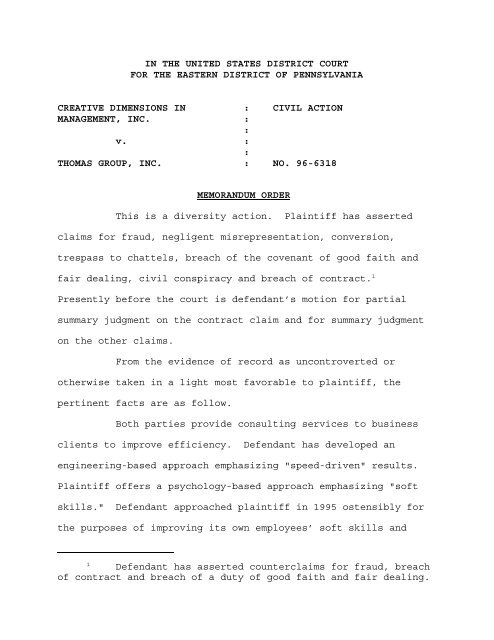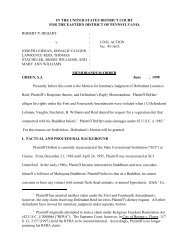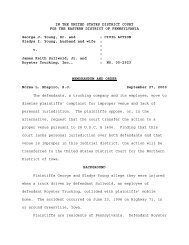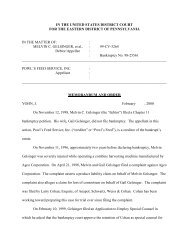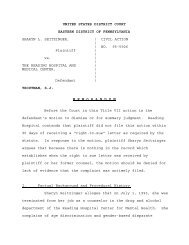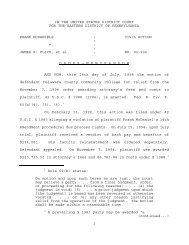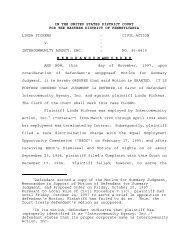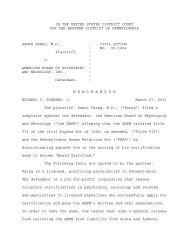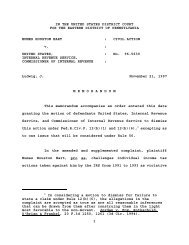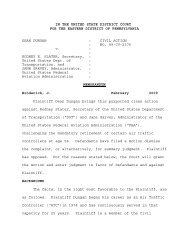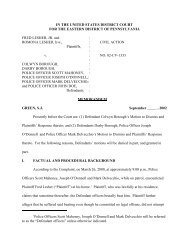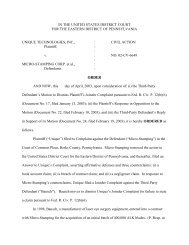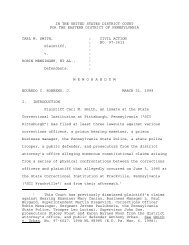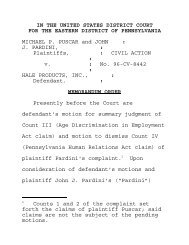Defendant has asserted counterclaims for fraud, breach of contract ...
Defendant has asserted counterclaims for fraud, breach of contract ...
Defendant has asserted counterclaims for fraud, breach of contract ...
Create successful ePaper yourself
Turn your PDF publications into a flip-book with our unique Google optimized e-Paper software.
IN THE UNITED STATES DISTRICT COURT<br />
FOR THE EASTERN DISTRICT OF PENNSYLVANIA<br />
CREATIVE DIMENSIONS IN : CIVIL ACTION<br />
MANAGEMENT, INC. :<br />
:<br />
v. :<br />
:<br />
THOMAS GROUP, INC. : NO. 96-6318<br />
MEMORANDUM ORDER<br />
This is a diversity action. Plaintiff <strong>has</strong> <strong>asserted</strong><br />
claims <strong>for</strong> <strong>fraud</strong>, negligent misrepresentation, conversion,<br />
trespass to chattels, <strong>breach</strong> <strong>of</strong> the covenant <strong>of</strong> good faith and<br />
fair dealing, civil conspiracy and <strong>breach</strong> <strong>of</strong> <strong>contract</strong>. 1<br />
Presently be<strong>for</strong>e the court is defendant’s motion <strong>for</strong> partial<br />
summary judgment on the <strong>contract</strong> claim and <strong>for</strong> summary judgment<br />
on the other claims.<br />
From the evidence <strong>of</strong> record as uncontroverted or<br />
otherwise taken in a light most favorable to plaintiff, the<br />
pertinent facts are as follow.<br />
Both parties provide consulting services to business<br />
clients to improve efficiency. <strong>Defendant</strong> <strong>has</strong> developed an<br />
engineering-based approach emp<strong>has</strong>izing "speed-driven" results.<br />
Plaintiff <strong>of</strong>fers a psychology-based approach emp<strong>has</strong>izing "s<strong>of</strong>t<br />
skills." <strong>Defendant</strong> approached plaintiff in 1995 ostensibly <strong>for</strong><br />
the purposes <strong>of</strong> improving its own employees’ s<strong>of</strong>t skills and<br />
1<br />
<strong>Defendant</strong> <strong>has</strong> <strong>asserted</strong> <strong>counterclaims</strong> <strong>for</strong> <strong>fraud</strong>, <strong>breach</strong><br />
<strong>of</strong> <strong>contract</strong> and <strong>breach</strong> <strong>of</strong> a duty <strong>of</strong> good faith and fair dealing.
taking advantage <strong>of</strong> the benefits <strong>of</strong> jointly marketing its product<br />
with plaintiff’s. The resulting discussions led to two<br />
agreements, the Services Agreement and the Strategic<br />
Alliance/Marketing License Agreement ("Strategic Alliance").<br />
Both agreements were executed by the parties on January 8, 1996<br />
at defendant’s <strong>of</strong>fice in Irving, Texas.<br />
The Services Agreement provided that plaintiff would<br />
<strong>of</strong>fer its services to "conduct and otherwise facilitate a TGIcustomized<br />
company-wide Cultural Trans<strong>for</strong>mation program." In<br />
return defendant was to compensate plaintiff by the payment <strong>of</strong> a<br />
fee plus expenses. <strong>Defendant</strong> paid the required fee <strong>of</strong> $325,000.<br />
The agreement contains a choice <strong>of</strong> law provision which reads:<br />
"This Agreement shall be governed by and construed in accordance<br />
with the laws <strong>of</strong> the State <strong>of</strong> Texas."<br />
The Strategic Alliance provided <strong>for</strong> a three-year term<br />
<strong>of</strong> joint marketing by the parties and a permanent license <strong>for</strong><br />
defendant to use plaintiff’s methodologies. Under the agreement,<br />
plaintiff was to develop customized products to be marketed<br />
jointly with defendant’s product. <strong>Defendant</strong> was fully to support<br />
the sale <strong>of</strong> such a joint product. In addition, each party was to<br />
"facilitate the engagement" <strong>of</strong> the other by its own clients.<br />
<strong>Defendant</strong> agreed to pay plaintiff a commission <strong>of</strong> ½ <strong>of</strong> 1% <strong>of</strong><br />
revenues from sales <strong>of</strong> its "TCT programs" and plaintiff agreed to<br />
pay defendant a commission <strong>of</strong> 11% <strong>of</strong> revenues derived from its<br />
2
clients during the term <strong>of</strong> the contact. <strong>Defendant</strong> at the time <strong>of</strong><br />
execution also paid a royalty <strong>of</strong> $250,000 <strong>for</strong> a license to use<br />
plaintiff’s methodologies.<br />
The agreement provided <strong>for</strong><br />
termination by mutual written consent <strong>of</strong> both parties. The<br />
license was to survive termination <strong>of</strong> the agreement.<br />
After the agreement was signed, defendant failed to<br />
support the joint marketing project and did not attempt to refer<br />
its clients to plaintiff. <strong>Defendant</strong> also failed to pay the<br />
royalty. Claiming that plaintiff failed to per<strong>for</strong>m its<br />
obligation to develop a product <strong>for</strong> joint marketing, defendant<br />
notified plaintiff <strong>of</strong> its intent to terminate the Strategic<br />
Alliance by letter on November 12, 1996. <strong>Defendant</strong> continued to<br />
use plaintiff’s materials into at least 1997.<br />
At court proceedings yesterday, the parties agreed that<br />
all <strong>of</strong> the claims herein are governed by Texas law.<br />
Plaintiff alleges that it was <strong>fraud</strong>ulently induced to<br />
turn over its materials and methodologies by false statements<br />
made by defendant prior to the execution <strong>of</strong> the <strong>contract</strong>s.<br />
<strong>Defendant</strong> argues it is entitled to judgment on the <strong>fraud</strong> claim<br />
because it entered into the agreements with the intent to<br />
per<strong>for</strong>m.<br />
It does not clearly appear from the summary judgment<br />
record that plaintiff will be unable to produce evidence from<br />
which a jury could reasonably conclude defendant had no intent to<br />
per<strong>for</strong>m its promised obligations. Summary judgment on this claim<br />
3
is not appropriate.<br />
The essence <strong>of</strong> plaintiff’s negligent misrepresentation<br />
claim is that defendant falsely promised to engage in the joint<br />
marketing program to obtain plaintiff’s materials at a reduced<br />
royalty. Plaintiff does not allege or present evidence that<br />
defendant failed to exercise due care in communicating its<br />
intent. Rather, plaintiff contends that defendant effectively<br />
communicated false promises <strong>of</strong> future per<strong>for</strong>mance.<br />
To be actionable under Texas law, a negligence<br />
misrepresentation must pertain to an existing fact and not a<br />
promise <strong>of</strong> future action. See Airborne Freight Corp. v. C.R. Lee<br />
Enterprises, Inc., 847 S.W.2d 289, 294 ("the sort <strong>of</strong> ‘false<br />
in<strong>for</strong>mation’ contemplated in a negligent misrepresentation case<br />
is a misstatement <strong>of</strong> existing fact") (emp<strong>has</strong>is added); Clardy<br />
Mfg. Co. v. Marine Midland Business Loans Inc., 88 F.3d 347, 357<br />
(5th Cir. 1996) (same); Perez v. ALCOA Fujikura, Ltd., 969 F.<br />
Supp. 991, 1008 (W.D. Tex. 1997) (misstatement regarding<br />
defendant’s future acts cannot sustain claim <strong>for</strong> negligent<br />
misrepresentation); 5636 Alpha Road v. NCNB Texas Nat. Bank, 879<br />
F. Supp. 655, 665 (N.D. Tex. 1995) (defendant entitled to<br />
judgment where alleged misrepresentation concerned future event).<br />
Plaintiff <strong>has</strong> adduced no evidence and does not contend that<br />
defendant negligently misrepresented facts existing at the time<br />
<strong>of</strong> the alleged misstatements. At court proceedings yesterday,<br />
4
plaintiff consented to the entry <strong>of</strong> judgment <strong>for</strong> defendant on<br />
this claim.<br />
<strong>Defendant</strong> argues that it is entitled to summary<br />
judgment on plaintiff’s claim <strong>for</strong> <strong>breach</strong> <strong>of</strong> the Service Agreement<br />
because defendant fully per<strong>for</strong>med its obligations by paying the<br />
specified fee. Plaintiff, however, points to other unfulfilled<br />
obligations including identification <strong>of</strong> five clients to be<br />
interviewed by plaintiff and refraining from use <strong>of</strong> plaintiff’s<br />
videotapes <strong>for</strong> external purposes without express permission.<br />
The <strong>for</strong>mer requirement appears to be <strong>for</strong> the sole benefit <strong>of</strong><br />
defendant in developing a program to improve defendant’s<br />
corporate environment. The latter provision, however, is another<br />
matter and, if credited, evidence <strong>of</strong> the prohibited use <strong>of</strong> the<br />
videotapes would constitute a <strong>breach</strong> <strong>of</strong> the parties’ agreement.<br />
<strong>Defendant</strong> requests partial summary judgment on<br />
plaintiff’s claim <strong>for</strong> lost pr<strong>of</strong>its from joint marketing under the<br />
Strategic Alliance because such pr<strong>of</strong>its are unduly speculative as<br />
the product to be jointly marketed was unique and untested. The<br />
marketing strategy may have been unique but the products to be<br />
<strong>of</strong>fered were essentially the parties’ established separate<br />
products. One could reasonably calculate likely lost pr<strong>of</strong>its<br />
from evidence <strong>of</strong> the success and pr<strong>of</strong>it margin <strong>of</strong> each party in<br />
marketing its program.<br />
5
Summary judgment on the <strong>contract</strong> claim is not<br />
appropriate on the record presented.<br />
Plaintiff’s claims <strong>for</strong> conversion and trespass to<br />
chattels are predicated on defendant’s alleged misappropriation<br />
<strong>of</strong> plaintiff’s methodologies and processes. To sustain these<br />
claims, plaintiff must show that it had property rights in the<br />
methodologies and processes and that defendant wrongfully<br />
deprived them <strong>of</strong> those rights. See Waisath v. Lack’s Stores,<br />
Inc., 474 S.W.2d 444, 447 (Tex. 1971) (elements <strong>of</strong> conversion are<br />
unauthorized and wrongful exercise <strong>of</strong> dominion and control over<br />
the personal property <strong>of</strong> another to the exclusion <strong>of</strong> or<br />
inconsistent with the owner’s rights). 2<br />
There is evidence, including statements by defendant’s<br />
<strong>of</strong>ficers and employees, to suggest defendant may have used<br />
plaintiff’s materials at least until February <strong>of</strong> 1997. If<br />
credited, evidence <strong>of</strong> <strong>fraud</strong> would put the validity <strong>of</strong> the license<br />
in dispute. It further appears that defendant may have exceeded<br />
the scope <strong>of</strong> the license.<br />
2<br />
The elements <strong>of</strong> trespass to chattels are essentially<br />
the same. The difference is that conversion entails a more<br />
serious deprivation <strong>of</strong> the owner’s rights such that an award <strong>of</strong><br />
the full value <strong>of</strong> the property is appropriate. See Restatement<br />
(Second) <strong>of</strong> Torts § 217 (trespass to chattels requires<br />
intentional dispossession or use or intermeddling with a chattel<br />
<strong>of</strong> another); § 222 (the actor is subject to liability <strong>for</strong><br />
conversion where the dispossession "seriously interferes with the<br />
right <strong>of</strong> the other").<br />
6
Plaintiff, however, <strong>has</strong> adduced no evidence to show it<br />
had recognizable property rights in its methodologies or<br />
processes. Moreover, rights in intangible property are not<br />
subject to conversion. Conversion encompasses theft <strong>of</strong><br />
intangible property only where the rights have been merged with a<br />
document. See Neles-Jamesbury, Inc. v. Bill’s Valves, 974 F.<br />
Supp. 979, 982 (S.D. Tex. 1997). The class <strong>of</strong> rights merged with<br />
a document is generally limited to commercial paper and other<br />
writings entitling the holder to legal rights and <strong>has</strong> not been<br />
extended to misappropriation <strong>of</strong> an idea capable <strong>of</strong> being<br />
expressed in a writing. See W. Page Keeton et al., Prosser and<br />
Keeton on Torts § 15 (1984). See also Ciccorp., Inc. v. Aimtech<br />
Corp., 32 F. Supp. 2d 425, 430 n.9 (S.D. Tex. 1998) (liability<br />
<strong>for</strong> conversion does not extend "to alleged unlawful dominion and<br />
control over intangible property”); Pebble Beach Co. v. Tour 18<br />
I, Ltd., 1996 WL 511928, *44 (S.D. Tex. Sept. 10, 1996) (no<br />
action <strong>for</strong> conversion <strong>of</strong> unique golf course design), aff’d, 155<br />
F.3d 526 (5th Cir. 1998). 3<br />
3<br />
To the extent that plaintiff <strong>has</strong> any intellectual<br />
property rights in the materials, state law claims <strong>for</strong> conversion<br />
and trespass to chattels would also be preempted by federal<br />
copyright law. See United States ex rel. Berge v. Board <strong>of</strong><br />
Trustees <strong>of</strong> the University <strong>of</strong> Alabama, 104 F.3d 1453, 1463 (4th<br />
Cir. 1997) (claim <strong>for</strong> conversion <strong>of</strong> ideas and methods preempted<br />
by Copyright Act); Daboub v. Gibbons, 42 F.3d 285, 289 (5th Cir.<br />
1995).<br />
7
Plaintiff’s methodologies and processes are admittedly<br />
intangible ideas. At court proceedings yesterday, plaintiff<br />
consented to entry <strong>of</strong> judgment <strong>for</strong> defendant on these two claims.<br />
The <strong>breach</strong> <strong>of</strong> a duty <strong>of</strong> good faith and fair dealing<br />
claim is premised on defendant’s "willfully failing to cooperate"<br />
with plaintiff.<br />
Under Texas law, there is no implied covenant <strong>of</strong> good<br />
faith and fair dealing in each <strong>contract</strong>. Texas does not<br />
recognize Restatement (Second) <strong>of</strong> Contracts § 205. See English<br />
v. Fischer, 660 S.W.2d 521, 522 (Tex. 1983); Central Sav. and<br />
Loan Ass’n v. Stemmons Northwest Bank, 848 S.W.2d 232, 238 (Tex.<br />
App. 1992).<br />
Texas <strong>has</strong> recognized an independent action <strong>for</strong> <strong>breach</strong><br />
<strong>of</strong> a duty <strong>of</strong> good faith between parties to a "special<br />
relationship," but <strong>has</strong> recognized such a special relationship<br />
only in the context <strong>of</strong> an insured and insurer. See Arnold v.<br />
National County Mut. Fire Ins. Co., 725 S.W.2d 165, 167 (Tex.<br />
1987). In doing so, the Court relied heavily upon the unequal<br />
bargaining power <strong>of</strong> the insurer and the special nature <strong>of</strong><br />
insurance that creates an incentive <strong>for</strong> an insurer arbitrarily to<br />
deny legitimate claims. Where these concerns are absent, Texas<br />
<strong>has</strong> declined to recognize such an implied duty. See Stewart<br />
Title Guar. Co. v. Aiello, 941 S.W.2d 68, 71 (Tex. 1997). Texas<br />
courts have found no special relationship to exist between<br />
8
suppliers and distributors, mortgagors and mortgagees, creditors<br />
and guarantors, lenders and borrowers and even franchisors and<br />
franchisees. See Central Savings, 848 S.W.2d at 239.<br />
There is no special relationship between commercial<br />
parties to an arms-length business agreement. Id. at 238; Adolph<br />
Coors Co. v. Rodriguez, 780 S.W.2d 477, 481 (Tex. App. 1989).<br />
That one businessman trusts another and relies upon him to<br />
per<strong>for</strong>m a <strong>contract</strong> does not give rise to a special relationship<br />
or create an implied a duty <strong>of</strong> good faith and fair dealing under<br />
Texas law. Farrah v. Mafrige & Kormanik, 927 S.W.2d 663, 675-76<br />
(Tex. App. 1996).<br />
Plaintiff states that the Strategic Alliance created a<br />
joint venture but <strong>has</strong> cited no case recognizing a special<br />
relationship between joint venturers under Texas law. Moreover,<br />
the plain language <strong>of</strong> the agreements is inconsistent with the<br />
creation <strong>of</strong> such a relationship. The Service Agreement provides:<br />
"[n]othing in this Agreement shall be construed as constituting a<br />
partnership or joint venture, or the relationship <strong>of</strong><br />
principal/agent between the parties." The Service Alliance<br />
states: "[n]othing in this Agreement shall be construed as<br />
constituting a partnership, or the relationship <strong>of</strong><br />
principal/agent between the parties."<br />
At court proceedings yesterday, plaintiff consented to<br />
the entry <strong>of</strong> judgment <strong>for</strong> defendant on the good faith claim as<br />
9
well. 4<br />
Plaintiff concedes in its brief that it <strong>has</strong> not<br />
supported its claim <strong>for</strong> civil conspiracy. Judgment will also be<br />
entered <strong>for</strong> defendant on this claim.<br />
ACCORDINGLY, this<br />
day <strong>of</strong> April, 1999, IT IS<br />
HEREBY ORDERED that defendant’s motion <strong>for</strong> partial summary<br />
judgment (Doc. #90) is GRANTED as to plaintiff’s claims <strong>for</strong><br />
negligent misrepresentation, conversion, trespass to chattels,<br />
<strong>breach</strong> <strong>of</strong> the duty <strong>of</strong> good faith and fair dealing and civil<br />
conspiracy and the motion is otherwise DENIED.<br />
IT IS FURTHER ORDERED that defendant’s counterclaim <strong>for</strong><br />
<strong>breach</strong> <strong>of</strong> a duty <strong>of</strong> good faith and fair dealing is DISMISSED.<br />
BY THE COURT:<br />
JAY C. WALDMAN, J.<br />
4<br />
It is the court’s understanding that having itself<br />
successfully argued in support <strong>of</strong> its summary judgment motion<br />
that Texas does not recognize an action <strong>for</strong> <strong>breach</strong> <strong>of</strong> a duty <strong>of</strong><br />
good faith by those sharing the relationship <strong>of</strong> the parties,<br />
defendant <strong>has</strong> acquiesced in the dismissal <strong>of</strong> its good faith<br />
counterclaim. Indeed, were defendant now to persist in pressing<br />
its claim, a question <strong>of</strong> judicial estoppel could be implicated.<br />
See Ryan Operations, G.P. v. Santiam-Midwest Lumber Co., 81 F.3d<br />
355, 361 (3d Cir. 1996). In any event, the court will dismiss<br />
this counterclaim consistent with its understanding <strong>of</strong><br />
defendant’s position from court proceedings yesterday, without<br />
prejudice promptly to seek reconsideration if defendant’s<br />
position in fact is that it but not plaintiff may pursue a good<br />
faith claim on the record presented.<br />
10


